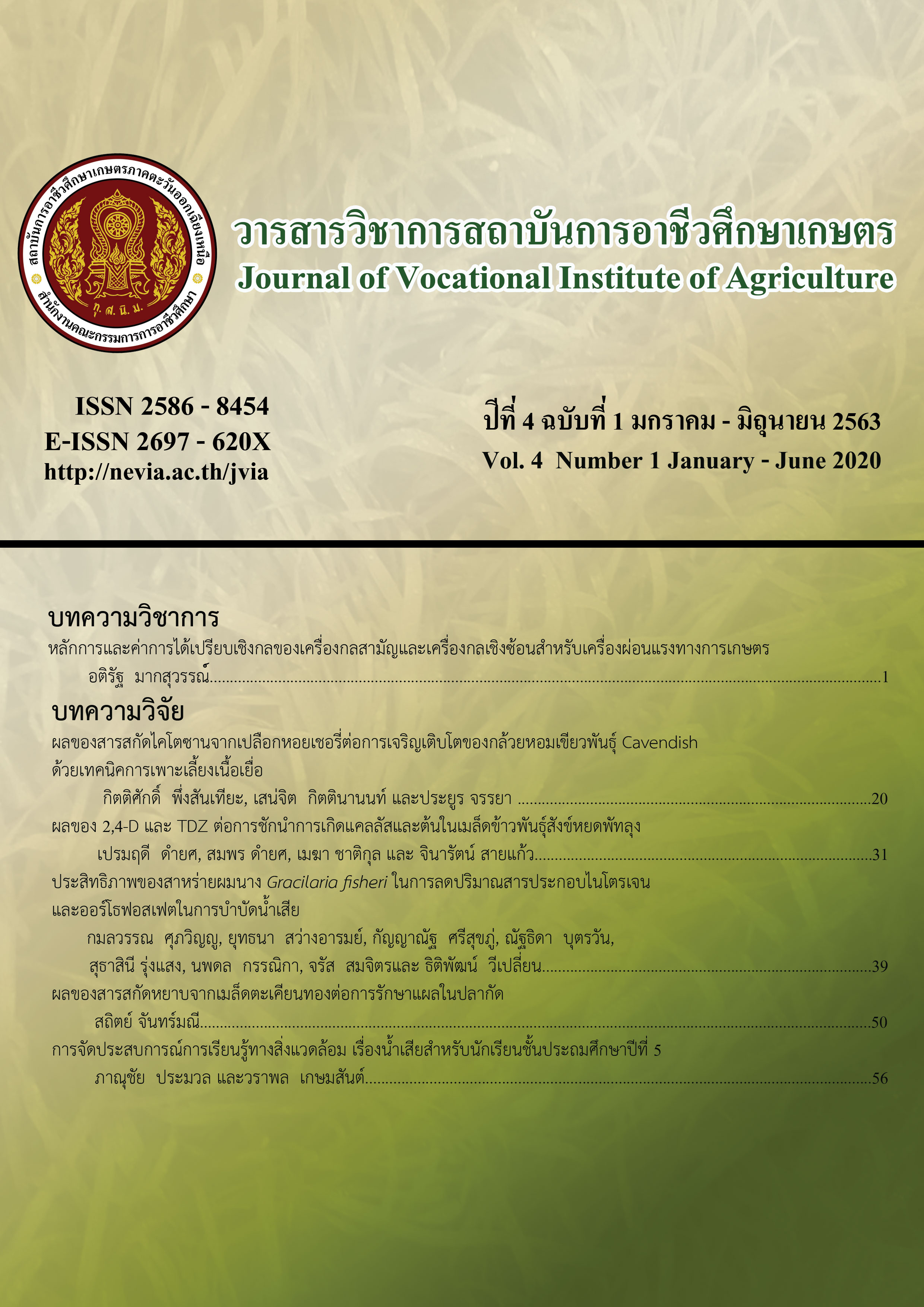Effect of 2,4-D and TDZ on Callus and Shoot Induction from seed of Rice (Oryza stiva L.) cv. Sangyodphatthalung
Main Article Content
Abstract
ABSTRACT
The study aimed to investigate the effects of 2,4-dichlorophenoxy acetic acid (2,4-D) on callus induction and thidiazuron (TDZ) on shoot induction of rice (Oryza stiva L.) cv. Sangyodphatthalung. The sterilized seeds were cultured on Murashige and Skoog (MS) medium without and containing 1, 2 and 3 mg/L 2,4-D for callus induction. The experiment was done using completely randomized design (CRD), 10 replications. After 4 weeks of culture, it was found that calli were induced on all the MS medium supplemented with 2,4-D. The largest callus (1.09 cm in diameter) was found on the MS medium added with 2 mg/L 2,4-D with friable and creamy yellow. In the case of shoot induction, the sterilized seeds were placed on MS medium without and containing 1, 2 and 3 mg/L TDZ for 4 weeks. The results showed that shoots were successfully developed directly from embryo without intervening callus stage. Multiple shoots from culturing seed were enhanced by increasing the concentration of TDZ from 1 to 3 mg/L and the highest average number of shoots (7.00 shoots/seed) was observed on MS medium containing 3 mg/L TDZ. So, it can be concluded that 2 mg/L 2, 4-D was suitable for callus induction and 3 mg/L TDZ was suitable for shoot induction.
Article Details
The content and information in articles published in the Journal of Vocational Education in Agriculture are the opinions and responsibility of the article's author. The journal editors do not need to agree or share any responsibility.
Articles, information, content, etc. that are published in the Journal of Vocational Education in Agriculture are copyrighted by the Journal of Vocational Education in Agriculture. If any person or organization wishes to publish all or any part of it or to do anything. Only prior written permission from the Journal of Vocational Education in Agriculture is required.
References
สำนักนโยบายและยุทธศาสตร์ข้าว. (2559). อุตสาหกรรมข้าวของประเทศไทย ปี 2558-2559: ทิศทางและศักยภาพการผลิตข้าวไทย. สืบค้นเมื่อ 20 มีนาคม 2561, http://www.dft.go.th/LinkClick.aspx?fileticket=p6iLTgSSD_4%3D&tabid=401
ศูนย์วิจัยข้าวพัทลุง. (2550). ข้าวพันธุ์สังข์หยดพัทลุง. กรุงเทพพฯ: สถาบันวิจัยข้าว กรมวิชาการเกษตร.
เปรมฤดี ดำยศ. (2551). การผลิตข้าวกล้องงอกพันธุ์สังข์หยดพัทลุง. พัทลุง: วิทยาลัยเกษตรและเทคโนโลยีพัทลุง.
พนิตพิมพ์ สิทธิศักดิ์ และคณะ. (2557). การผลิตและการตลาดข้าวสังข์หยดของเกษตรกรในจังหวัดพัทลุง. แก่นเกษตร. 42(1). 493-498.
ประชาชาติธุรกิจ. (2562). ข้าวเปลือกสังข์หยด GI พุ่ง 2.5 หมื่นบ./ตันอเรื่อง. สืบค้นเมื่อ 10 พฤษภาคม 2562, จาก https://www.prachachat.net/local-economy/news-275093
เปรมฤดี ดำยศ. (2538). การแยกโพรโทพลาสต์ข้าวขาวดอกมะลิ 105. ใน การประชุมวิชาการวิทยาศาสตร์และเทคโนโลยีแห่งประเทศไทย ครั้งที่ 21 (น. 266-267). ชลบุรี: โรงแรมแอมบาสซาเดอร์ซิตี้.
ยงศักดิ์ ขจรผดุงกิตติ และอัญชลี จาละ. (2558). ผลของ 2,4-D และ kinetin ชักนำให้เกิดแคลลัสในข้าวพันธุ์ขาวดอกมะลิ 105 และปทุมธานี 1. Thai Journal of Science and Technology. 4(3). 227-235.
ภพเก้า พุทธรักษ์ และคณะ. (2556). การชักนำแคลลัสจากการเพาะเลี้ยงเมล็ดของข้าวหอมมะลิ 105 และข้าวเหนียว กข 6. Naresuan Phayao Journal. 6(2). 100-105.
อรุณี ยูโซ๊ะ และสมปอง เตชะโต. (2558). การขยายพันธุ์ข้าวหอมกระดังงาโดยการเพาะเลี้ยงปลายยอดภายใต้ระบบไบโอรีแอคเตอร์. วารสารพืชศาสตร์สงขลานครินทร์. 2(3). 12-16.
พันทิวา ทีรวม และขวัญเดือน รัตนา. (2560). การชักนำให้เกิดแคลลัสและต้นใหม่ของข้าวเจ้าหอมนิล. แก่นเกษตร. 45(1). 1052-1059.
เปรมฤดี ดำยศ. (2550). เทคนิคการเพาะเลี้ยงเนื้อเยื่อพืช. พัทลุง: วิทยาลัยเกษตรและเทคโนโลยีพัทลุง.
Upadhyaya, G., et al. (2015). In vitro callus induction and plant regeneration of rice (Oryza sativa L.) var. ‘Sita’, ‘Rupali’ and ‘Swarna Masuri’. Asian Journal of Plant Science and Research. 5(5). 24-27.
Repalli, S. K., et al. (2017). Regeneration Enhancement in Tissue Culture of Indica Rice’s through Partial Desiccation and Chemical Supplements. Journal of Plant Biochemistry & Physiology. 5(3). 1-4.
Yoshida, T. & Kato, H. (1996). In Vitro Propagation of Hybrid Rice (Oryza sativa L.). Japan Agriculture Research Quarterly. 30(1). 9-14.
Yookongkaew, N., et al. (2007). Development of genotype-independent regeneration System for transformation of rice (Oryza sativa ssp. indica). Journal of Plant Research. 120. 237–245
Song, Y. (2014). Insight into the mode of action of 2,4‐dichlorophenoxyacetic acid (2,4‐D) as an herbicide. Journal of Integrative Plant Biology. 56(2). 106-113.
Michiba, K., et al. (2001). Increasing ploiding level in cell suspension cultures of Doritaenopsis by exogenous application of 2, 4-dichlorophenoxyacetic acid. Physiology Planta. 112. 142-148.
Murthy, B. N. S., et al. (1998). Review Thidiazuron: a potent regulator of in vitro plant morphogenesis. Society for In Vitro Biology. 34(4). 267-275.
Gairi, A. & Rashid, A. (2004). TDZ-induced somatic embryogenesis in non-responsive caryopses of rice using a short treatment with 2,4-D. Plant Cell Tissue Organ Culture. 76. 29–33.
Visser, C., et al. (1992). Morphoregulatory role of thidiazuron. Substitution of auxin and Cytokinin requirement for the induction of somatic embryogenesis in geranium hypocotyl cultures. Plant Physiology. 99. 1704–1707.

